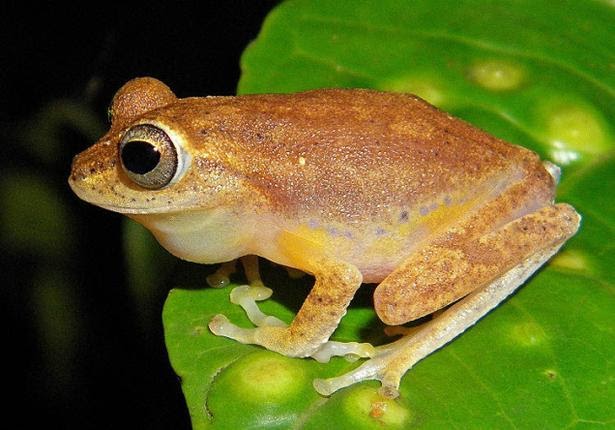Biodiversity & Environment
Myristica Swamp Treefrog
- 14 Dec 2020
- 4 min read
Why in News
Recently, Myristica swamp treefrog has been recorded for the first time in Kerala's Thrissur district.
Key Points
- Scientific Name: Mercurana myristicapalustris
- About:
- These are endemic to the Western Ghats.
- Rare arboreal species (Pertaining to moving about, living in or among trees).
- Active only for a few weeks during their breeding season.
- Unique Breeding Behaviour:
- The breeding season, unlike for other frogs, starts in the pre monsoon season (May) and ends before the monsoon becomes fully active in June.
- Before the end of the breeding season, the female frogs along with their male counterparts descend on the forest floor.
- The female digs the mud and lays eggs in shallow burrows in mud. After breeding and egg laying, they retreat back to the high canopies of the tree and remain elusive till the next breeding season.
Myristica Swamps
- About:
- The Myristica swamps are tropical freshwater swamp forests with an abundance of Myristica trees.
- Myristica trees are the most primitive of the flowering plants on earth.
- The evergreen, water-tolerant trees have dense stilt roots helping them stay erect in the thick, black, wet alluvial soil.
- The trees form a fairly dense forest with a closed canopy.
- The swamps are typically found in valleys, making them prone to inundation during monsoon rains.
- The Myristica swamps are tropical freshwater swamp forests with an abundance of Myristica trees.
- Significance:
- Research & Study: These swamps are considered as living museums of ancient life and could promote better understanding of the influence of climate change on the evolution of plants.
- Check Vagaries of Extreme Events: These swamps have high watershed value. When they are drained, filled or otherwise disturbed, their water holding capacity is lost, resulting in floods and erosion during the rainy season and dry streambeds the rest of the year.
- Habitat: Provide habitat for a rich diversity of invertebrate and vertebrate species, including amphibians, reptiles and mammals.
- It is estimated that the wetlands contain 23% of butterflies, more than 50% of amphibians, more than 20% of reptiles and birds in the whole of Kerala.
- Carbon Sequestration: These have higher potential to store carbon than nearby non-swamp forests. They function as carbon sinks and can store carbon produced by upland agriculture, forestry and other land uses.
- Present Status:
- Studies have shown that the swamps, which would have occupied large swathes of the thickly- wooded Western Ghats in the past, are now restricted to less than 200 hectares in the country.
- Further, the Myristica swamps of the Western Ghats are fragmented, with Kerala holding a major share of this habitat.
- Leaving aside a few more patches in Karnataka and Goa, this exceptional wetland has almost disappeared from the Indian subcontinent due to the climatic alteration over the last 18,000 to 50,000 years (Late Pleistocene period).







